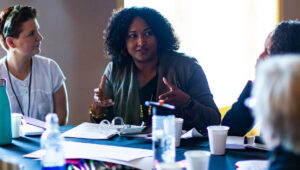“Let’s run an experiment and see what happens.”
I say these words at least twice a week with complete freedom. Not just the freedom to take the risk, but the freedom from being attached in any way to the outcomes. Sure, I have my hunch. I’ve been doing this awhile, after all. But in this scenario, my expertise counts for very little; I am not the audience, and the audience is the expert in finding new and creative ways to confound me. The secret is that this is what actually makes it exciting.
An organization where you are free to run as many experiments as you need to, to test and iterate out in the world in full view of your audience, to blow up something that’s been proven effective on the chance that something else might work even better, sounds like creative utopia. As the executive director of a 10-year-old, all-volunteer participatory community library, I get to experience this every day. In my day job.
I work as a user experience designer for websites and apps, where generating ideas for the sole purpose of watching half of them fail (and then watching the next generation of ideas replace those that just succeeded) is not only the job description, but part of the culture. We celebrate the failures because it means we made a leap, we overshot, we pushed the button for the future and the elevator just wasn’t ready to stop on that floor yet.
I spend a lot of time thinking about why I revel in my failures as a designer and why they can be so debilitating as an executive director and founder. Why temporarily disappointing users is what I get paid for and why the prospect of disappointing our community is a paralyzing jolt straight to my heart. I think a lot of it comes down to the cultural conditions around each.
Design & Tech Conditions:
- Be bold, take risks.
- Fail fast.
- Fail often.
- It’s not finished? Not functional? Not in color? Test it anyway.
- You are not your ideas and your worth is not tied to their success.
Small Arts Organization Conditions:
- Be bold, take risks.
- Plan meticulously to secure funding. Be sure to budget for the exact number of failures you anticipate.
- Attempt to control for every variable (and invent some imaginary ones, just to be safe). Perfect and polish, because this may be the only shot you get.
- You can fail, but not too big. And definitely not in public, or your city will disown you.
- Try to do it all for free because you value access and resourcefulness.
- When things don’t work out, keep yourself up at night wondering, “Is my idea bad, or am I just bad at my job?”
Notice first that neither of these sets of conditions are actually about who we claim to care for: the user, the audience, or the community. Both are rooted in messages that I’ve heard often from other folks in these fields, some of which I’ve painfully internalized more than others.
The first set comes from a place of abundance; the design and tech sectors are flush, and hundreds of these failures will only make them flusher. But they also come from a place of privilege, where a safety net is automatically assumed. The “risk” inherent in failure isn’t quite as big of a risk as we pride ourselves on taking.
The second is reflective of scarcity, the toxic thinking that can be mistaken for pragmatism when you’ve made your home in that mindset for too long — as many small, under-resourced organizations do. There is no room in those destructively high expectations to nurture healthy growth.
But they do plainly detail how much greater the cost of failure is without a safety net. Not having enough room to fail leads to paralysis around failure leads to feeling like a failure. After a while, it’s easy to see how these conditions become self-reinforcing and why one might start bypassing “Be bold, take risks” in the interest of less brutal options.
Of course, there is a massive middle ground to explore between “failure is the end of everything” and “if you’re not failing, you’re not innovating,” which is also unhelpful and reductive as a bar to meet for organizations working to scale or stabilize. I don’t know where that sweet spot is yet, but I’m looking forward to finding it.


